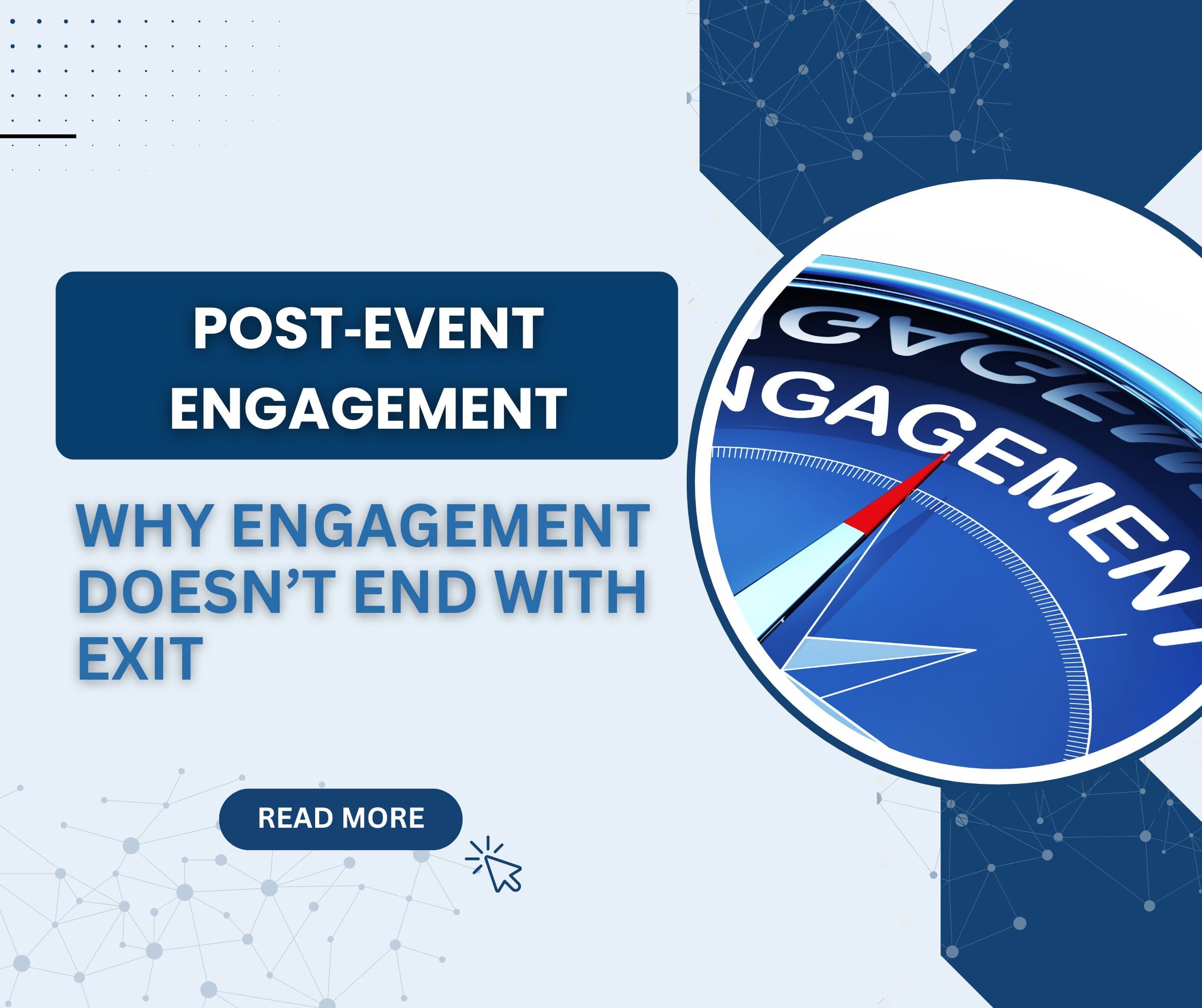The close of an event does not mark the end of the buyer journey—in fact, it signifies the beginning of a deeper, more strategic phase of engagement. In today’s sophisticated B2B landscape, surface-level experiences such as flashy stands, branded merchandise, and high-profile keynotes are no longer sufficient. Today’s enterprise buyers expect sustained, highly personalised interactions that extend well beyond the event floor. Forward-thinking marketers understand that the true opportunity lies in the post-event phase—a crucial window in which memory, trust, and momentum converge to influence purchasing decisions.
According to Forrester’s 2024 global survey,
92% of B2B marketers are prioritising more robust post-event engagement, while 77% are developing strategies for year-round buyer interaction.
Why Post-Event Is a Strategic Funnel Stage
While upper-funnel efforts such as brand awareness and lead capture are vital, they rarely translate into revenue without sustained follow-up. The post-event window is when buyer intent is most apparent and momentum is at its peak. Every scanned badge, attended session, and stand conversation represents a signal of interest that must be acted upon.
Forrester reports that organisations engaging prospects beyond the event timeline achieve up to 30% faster pipeline velocity. This is more critical than ever, as 75% of B2B deals now require longer sales cycles compared to 2023.
Without deliberate follow-through, intent wanes, leads grow cold, and other voices dominate the digital landscape. If your brand isn’t visible during this critical period, a competitor’s will be. Post-event engagement is not an optional extra—it’s a strategic necessity.
Common Post-Event Follow-Up Mistakes
Even the most well-executed events can falter without effective follow-up. Common errors include:
- Generic thank-you emails that fail to offer a compelling next step.
- Delayed outreach, which misses the narrow window of peak intent—despite HubSpot’s recommendation to follow up within 48 hours.
- Disjointed handovers between marketing and sales teams, leading to a loss of context and continuity.
- Unsegmented outreach, which fails to acknowledge attendees’ specific interests and interactions.
These pitfalls damage both credibility and conversion potential. Forrester highlights the need to extend the event narrative rather than restarting the conversation from scratch.

High-Impact Post-Event Engagement Tactics
A. Rapid Segmentation and Personalisation
Relevance and speed are essential. Immediately after the event, segment attendees based on their activity—such as stand visits, session participation, and resource downloads. Use CRM tools integrated with intent platforms to group contacts by role, business challenge, and buying stage.
Examples of actionable segments:
- AI Track Attendees – attended technical sessions and downloaded AI-specific content
- Live Demo Participants – took part in product demonstrations
- Passive Registrants – registered but did not attend or engage onsite
Forrester’s B2B lifecycle engagement model emphasises the value of tailored outreach at each interaction point, particularly following an event (Forrester, Gartner).
B. Deliver Content that Builds Trust
Avoid pushing a sales agenda too early. Focus instead on delivering value-driven content:
- Session recaps offering key insights and thoughtful follow-up questions
- On-demand content such as recordings and presentations
- Industry reports or benchmarking studies that relate to attended sessions
- Exclusive networking opportunities to maintain engagement among peers
- Personalised consultations based on demonstrated interest
Forrester’s 2025 recommendations suggest content that nurtures learning and supports informed decision-making.
-
Orchestrated Multi-Channel Campaigns
Using a single channel restricts reach. Leading marketing teams deploy integrated strategies across:
- Email: Deliver targeted, value-driven follow-up
- LinkedIn: Retarget attendees with thought leadership
- In-product messaging: For SaaS, in-app messages help re-engage users
- SMS/WhatsApp: Light-touch reminders for high-value prospects
Multi-channel coordination increases message retention and keeps your brand front-of-mind.
D. Cadence and Timing
HubSpot underscores the importance of engaging within 48 hours of event completion to capitalise on attendee enthusiasm.
Recommended cadence:
- Day 1: Personalised thank-you message and event resources
- Day 3: Curated content aligned to session attendance
- Day 7: Invite to speak with an expert or account lead
- Day 14–30: Enter into a longer-term nurture or reactivation flow
This sequence keeps engagement active and provides insight into buyer interest levels.
Measuring What Matters
Relying on traditional metrics such as attendance or badge scans limits visibility. Modern post-event performance should focus on meaningful engagement and conversion potential:
- Email metrics: open rates, click-throughs, and CTA engagement
- Content analytics: time-on-page, video views, asset downloads
- MQL to SAL conversion: transition from marketing-qualified to sales-accepted leads
- Pipeline influence: revenue attribution from event-related outreach
- Time-to-engagement: a key predictor of buyer readiness (Gartner)
Gartner advocates for multi-touch attribution models to accurately map engagement to pipeline and performance.
Creating a Marketing–Sales Alignment Framework
Seamless post-event execution requires tight alignment between marketing and sales functions. This begins long before the event:
- Joint pre-event planning to agree on segmentation, messaging, and goals
- Shared scorecards to unify KPIs across teams
- Consolidated data infrastructure for seamless lead tracking
- Post-event debriefs to evaluate performance and refine playbooks
Both Gartner and Forrester emphasise the importance of collaborative systems and unified reporting to unlock the full potential of event-generated engagement (Forrester, SalesIntel).
Acumen Intelligence: Transforming Engagement into Revenue
We view post-event as the most valuable phase of the buyer journey:
- AI-driven analytics reveal subtle buyer signals and preferences
- Automated segmentation ensures messaging precision
- ABM orchestration delivers account-specific multi-touch journeys
- Intelligent reactivation flows re-engage contacts over time
Our clients routinely see an increase in post-event engagement and shorter sales cycles. We transform event momentum into pipeline growth.
Conclusion
Events generate visibility, but post-event engagement converts interest into revenue. In 2025, market leaders will be those who view follow-up not as a closing act but as the strategic engine of their funnel. With intelligent segmentation, multi-channel communication, and tight sales integration, fleeting event interest becomes lasting commercial impact.
If your event strategy ends at the exit, you’re forfeiting the most powerful opportunity for influence. Make post-event engagement the cornerstone of your marketing performance.

